I love nature. I may spend all my time in a workshop making objects and fulfilling my need to create, but there is no place that I feel more at peace and more connected to the universe than immersed in nature. I love the subtle organic beauty found in natural environments, from graceful grassland, fearsome forests, and desolate deserts to staggering stonescapes that might as well be an alien planet.
And in terms of design I love patterns and contrast (like that found in the Hermès Arceau Cheval Cosmique). Lines, shapes, and colors repeating can give such visual energy, and I love finding it within art and design.
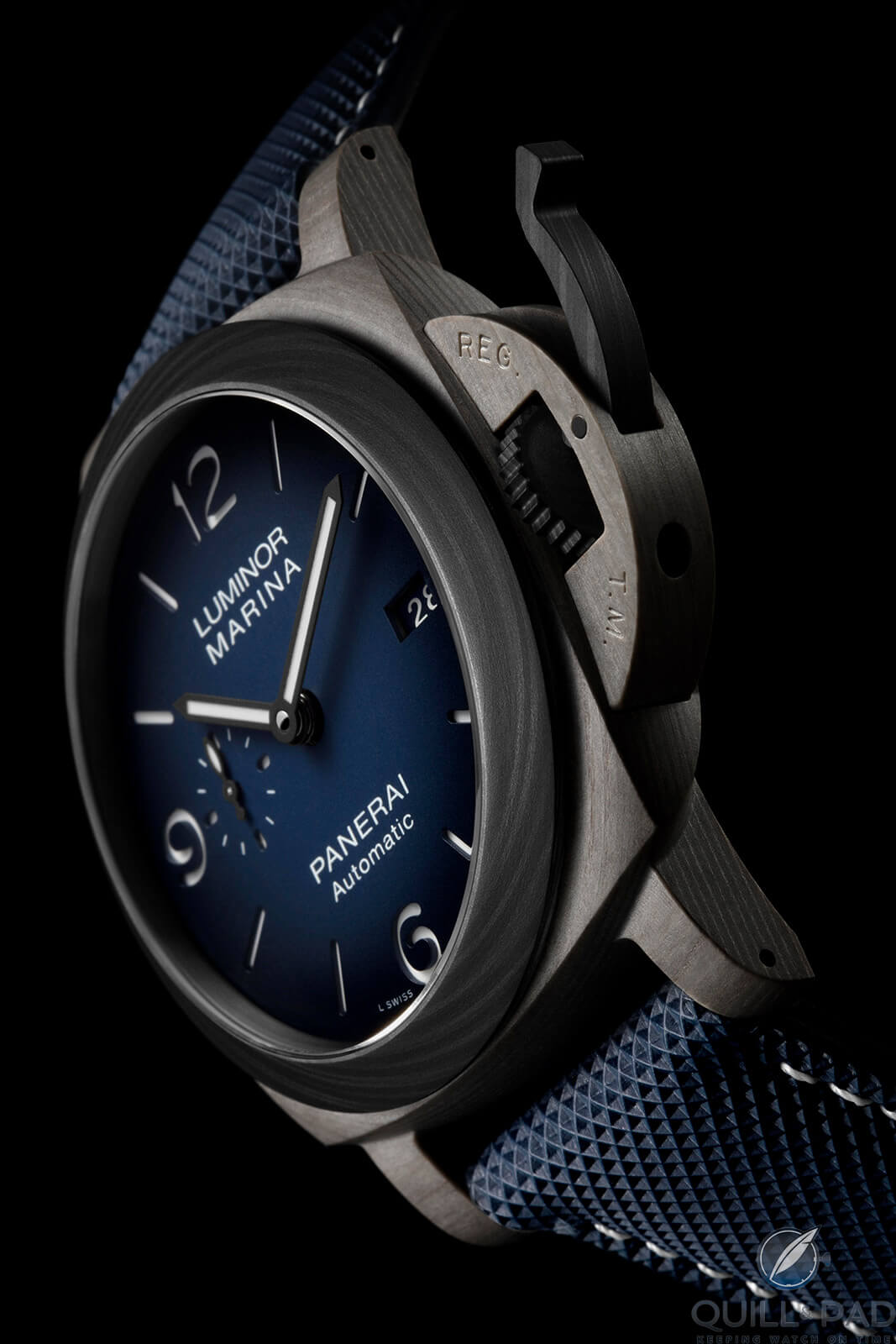
Panerai Luminor Marina Fibratech PAM01663
But contrast, well, contrast just may be one of my favorite things in the world, specifically because it has the power to highlight multiple things at once instead of pulling focus. Contrast facilitates perspective shifts, plain and simple.
So how does that have any relevance to nature? Because epic landscapes, usually showcasing wondrous contrast and incredible patterns, have the ability to leave me speechless (for once). All around the world there are incredible examples, and some of my favorites are basalt columns.
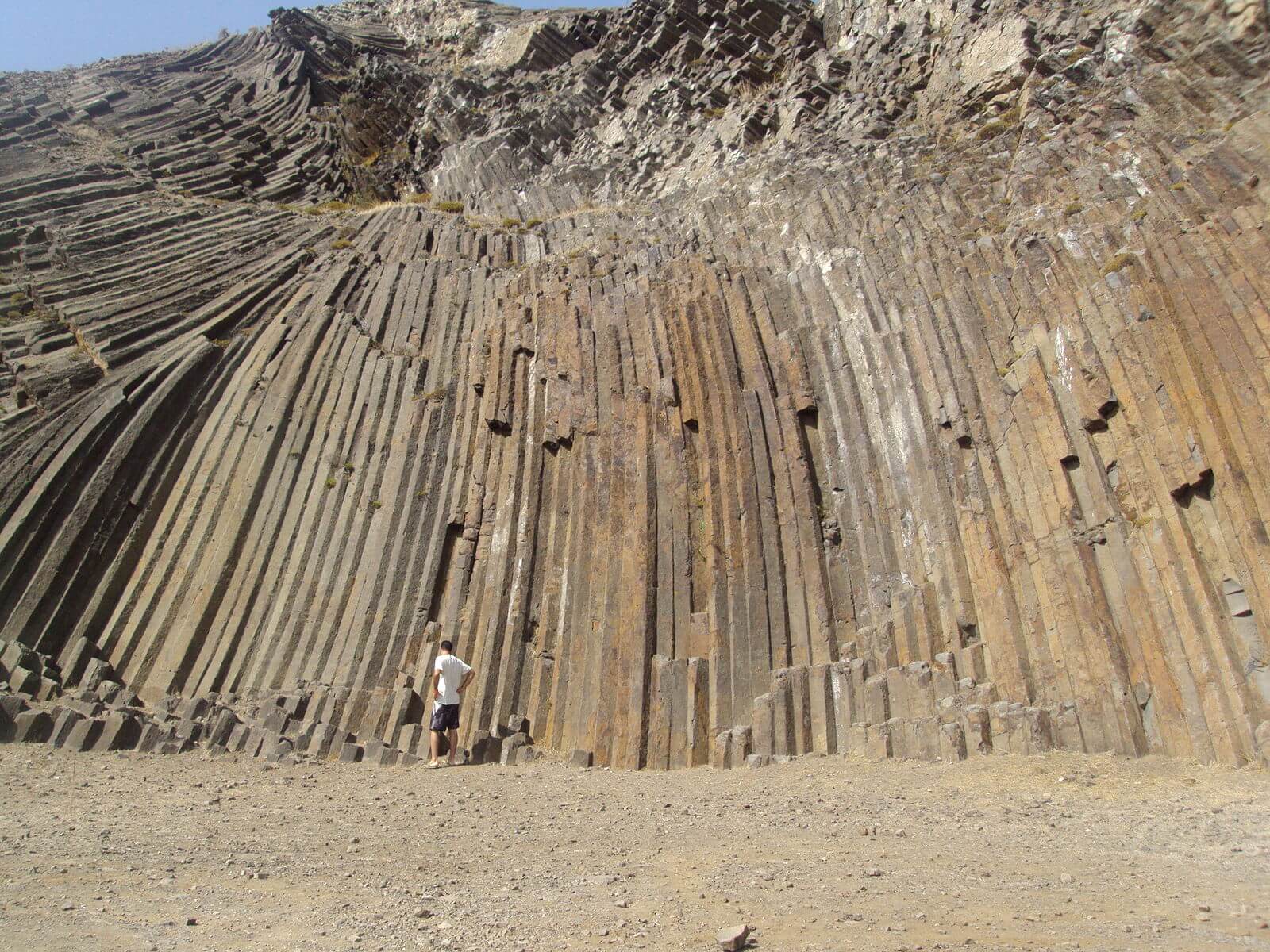
Basalt columns on Porto Santo, Madeira (photo courtesy Nmnogueira/Wikipedia)
What’s a basalt column? You may well have seen at least photos of them, even if you weren’t aware what they are called. Basalt columns are geologic formations so stunning that for millennia cultures have pointed to them as evidence of gods, aliens, and ancient cultures.
Basically, basalt columns are the remnants of magma flowing upward through the crust, igneous rock that cooled while still underground, cooling from the top down and center out, so as it formed it created an internal crystalline structure that shrank and fractured from the crystalline structure next to it, usually at precise geometric angles.
This fracturing most commonly created hexagons, sometimes spanning hundreds or thousands of meters. Then, over millions of years, the land above eroded away and the geological formations were exposed, looking like purposefully made structures.
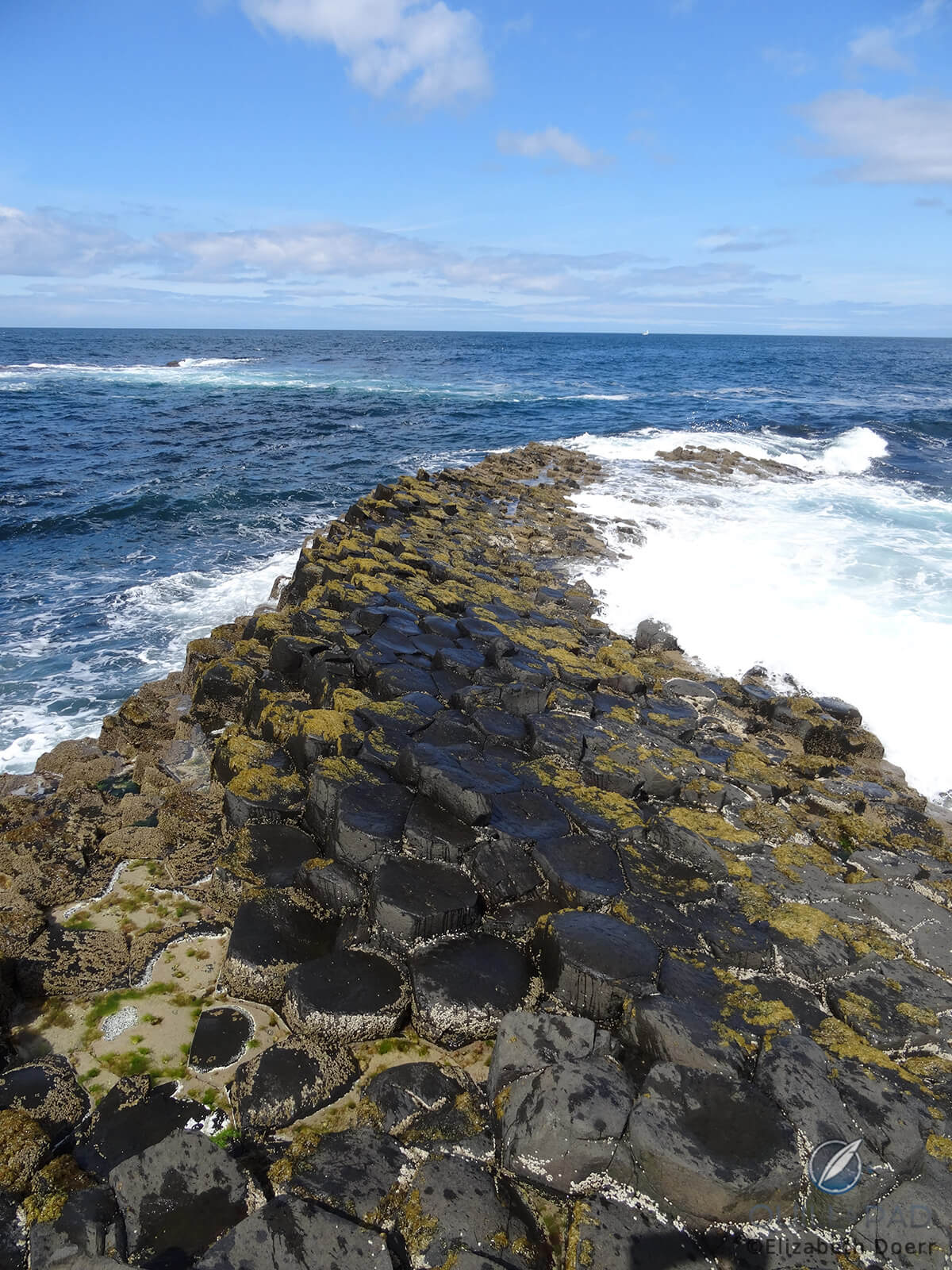
Some of the basalt columns found at Giant’s Causeway in County Antrim, Ireland
Basalt columns are found around the world, in Russia, Japan, India, Mexico, Israel, Ireland, the United States, and numerous other countries. Famous examples are Giant’s Causeway in Ireland, the Svartifoss waterfall in Iceland, and Fingal’s Cave in Scotland. Heck, they have even been spotted on Mars in the Marte Vallis region by the Mars Reconnaissance Orbiter (which proves we basically live on an alien planet).
Basalt columns are so stunning that every single one is an attraction for travelers and photographers alike, causing wonder and awe. And they do so in me, combining my favorite things: nature, patterns, and contrast (with the surrounding environment). And they are usually in some of the most stunning locations in the world. Basalt is highly regarded in my mind because physics helps it create incredible geometric beauty that juxtaposes with the organic chaos around it.
And now one of my favorite minerals in the world has also been tapped by constant material experimenter Panerai for the case of the new Luminor Marina Fibratech.
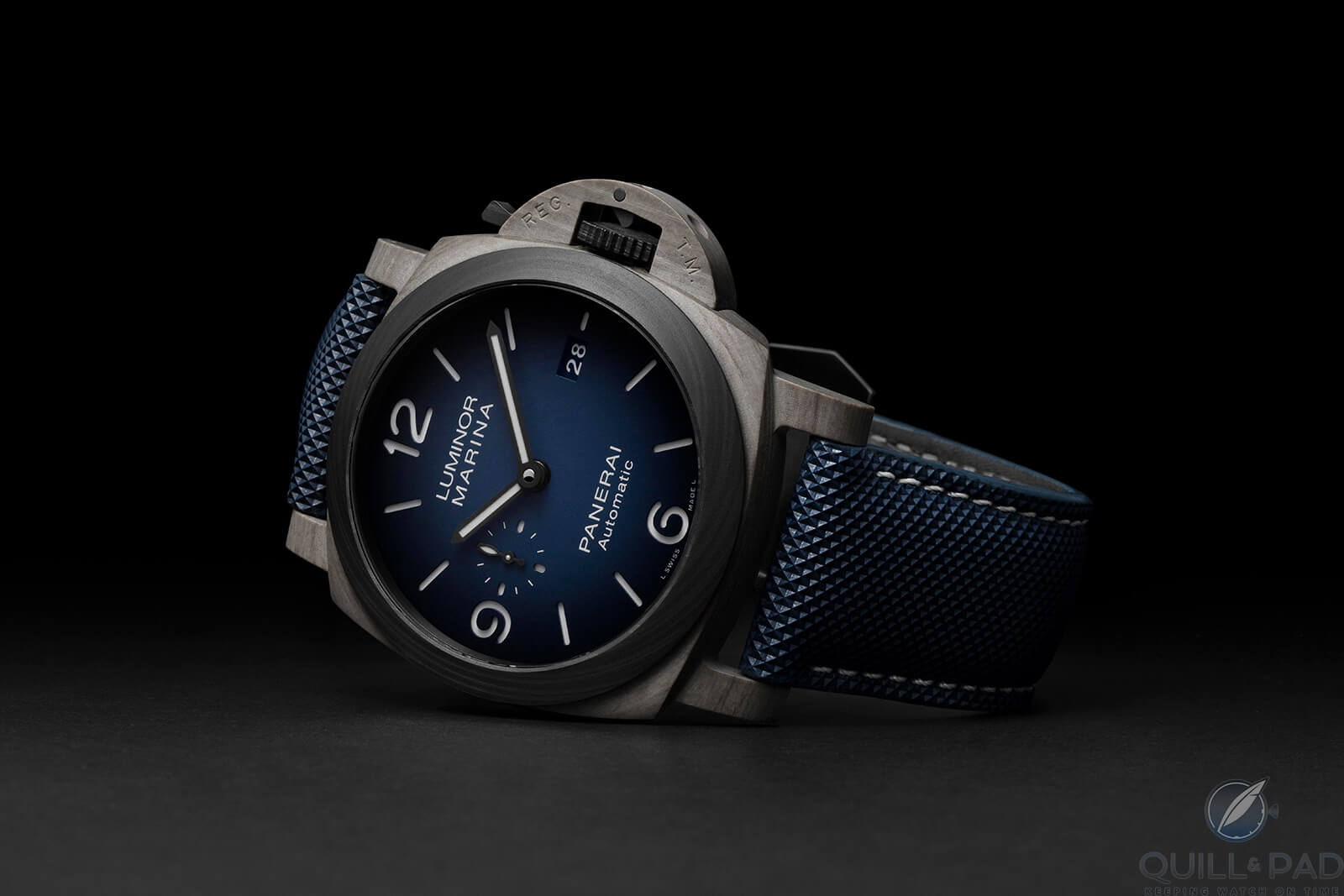
Panerai Luminor Marina Fibratech PAM01663
The basalt-based Fibratech, a unique carbon-fiber like material, is the latest example of Panerai seeking to create ever sturdier and more durable watches for those seeking adventure. But first let’s explore the Luminor Marina Fibratech and then delve into the very cool technology of the material.
Panerai Luminor Marina Fibratech
Like many Panerai watches displaying material innovation, the Luminor Marina Fibratechis a fairly straightforward watch. The design is not wild, and the mechanics are what you would expect in this model. An automatic Caliber P.9010 displays the hours, minutes, seconds, and date.
Aside from a gradient blue dial on the PAM01663, the focus is on the case material. There is a limited-edition version (PAM01119) with some differences, which I will cover below, but mostly it is a straightforward Luminor Marina watch that’s a vehicle for exhibiting a new material innovation.
That innovation is the basalt-based Fibratech.
A composite material not unlike other fiber-based composites, Fibratech is used for the case and Safety Lock crown protector. The case back is a more traditional (for Panerai) titanium, while the crown and crown lever are crafted from a previous material innovation, Carbotech.
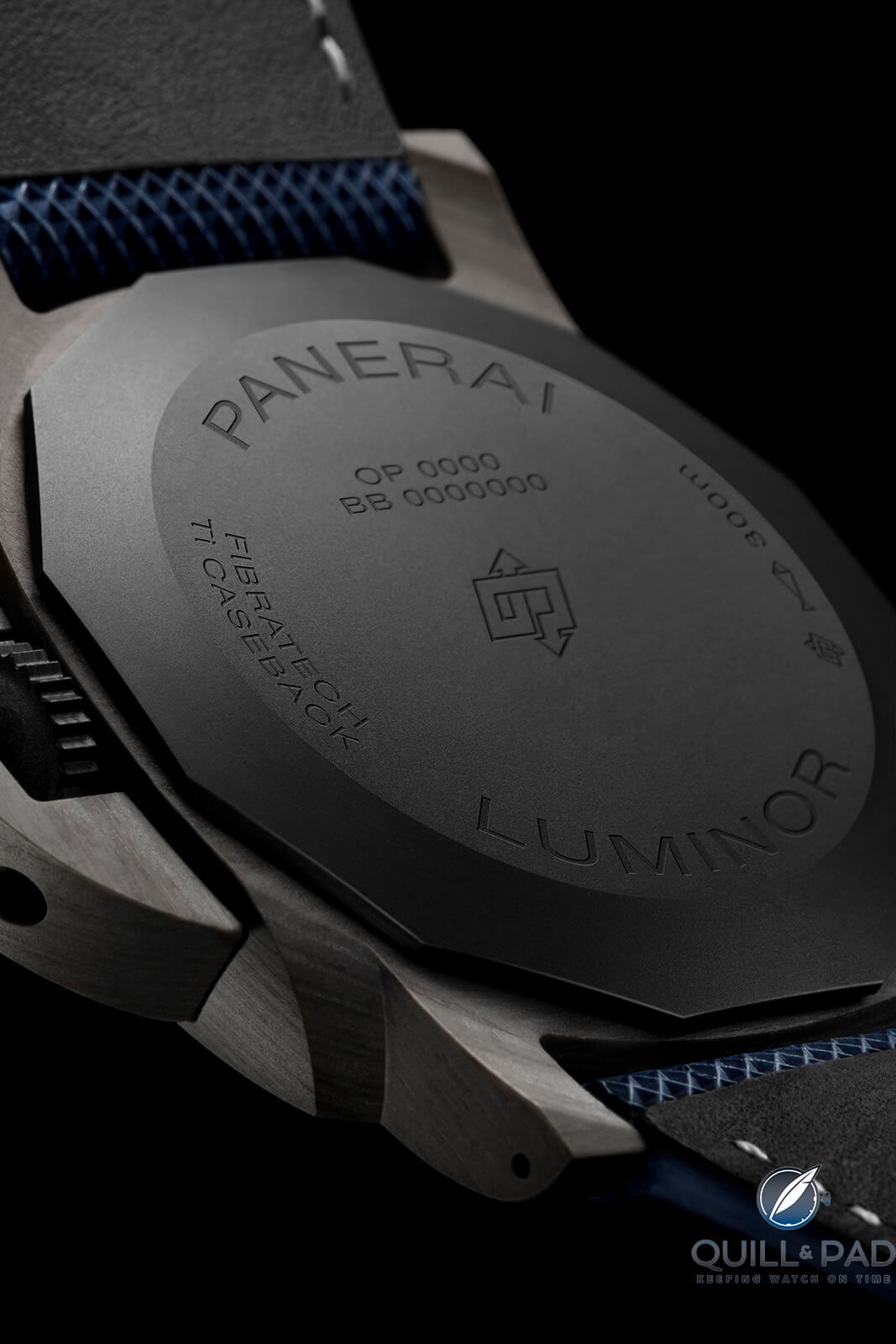
Back of the Panerai Luminor Marina Fibratech PAM01663
Fibratech is a lighter grey than Carbotech, so the difference in the materials stands out, creating contrast between the two. That contrast is interesting because these components usually are made from the same material, so the combination adds character to the material innovation.
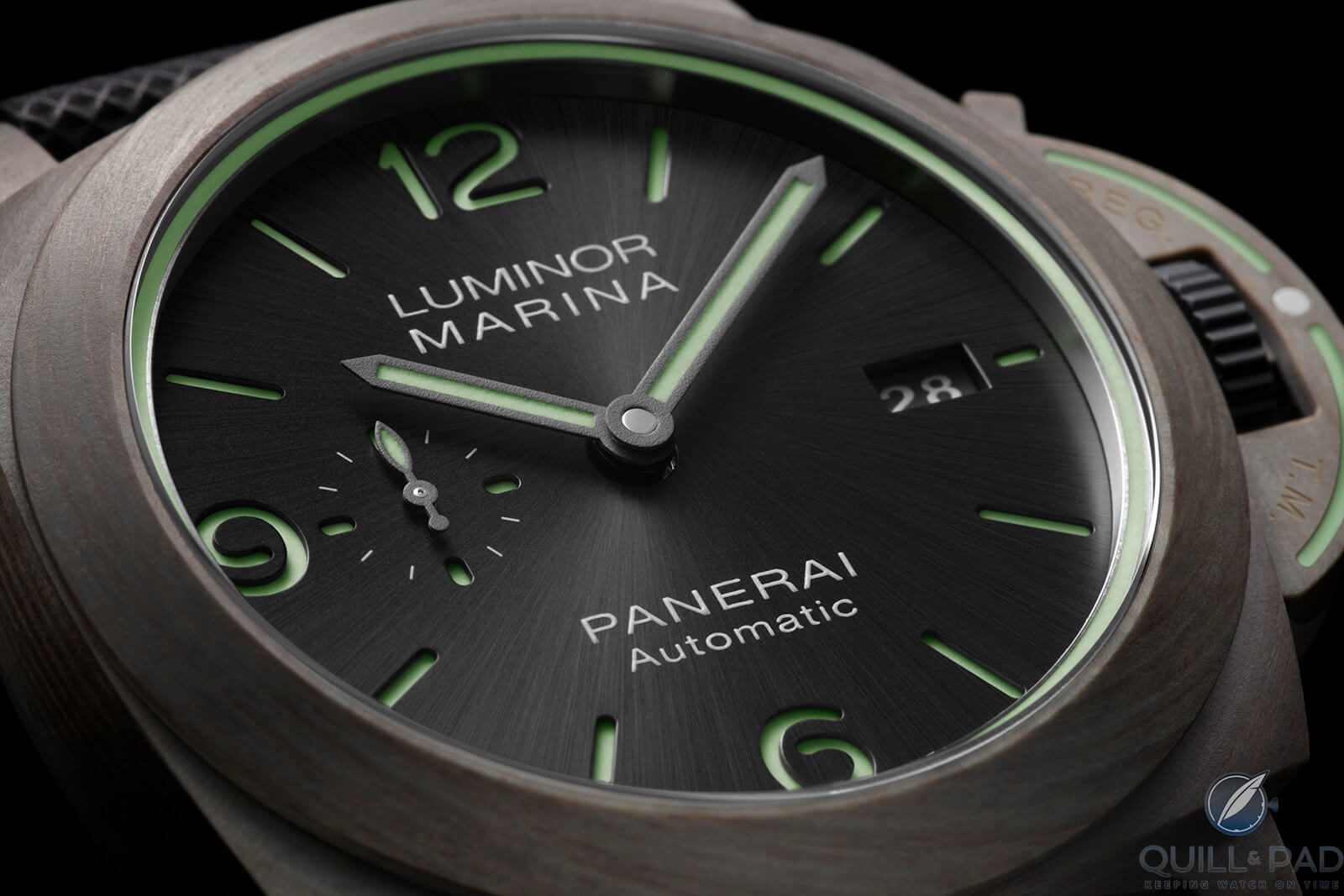
Panerai Luminor Marina Fibratech PAM01119
In the limited edition we see more design flair come in. The PAM01119 removes the Carbotech for everything except the crown, replacing it with the Fibratech. This creates a much more consistent grey tone overall, something matched by the anthracite-grey sunray-brushed dial. The contrast of the crown is almost negligible when the final change is considered: abundant Super-LumiNova.
While the non-limited version features white Super-LumiNova on the numerals and the hands, the limited edition changes that to green and splashes it everywhere. The Luminor Marina and Panerai logo are filled with lume as well as a ring around the dial periphery.
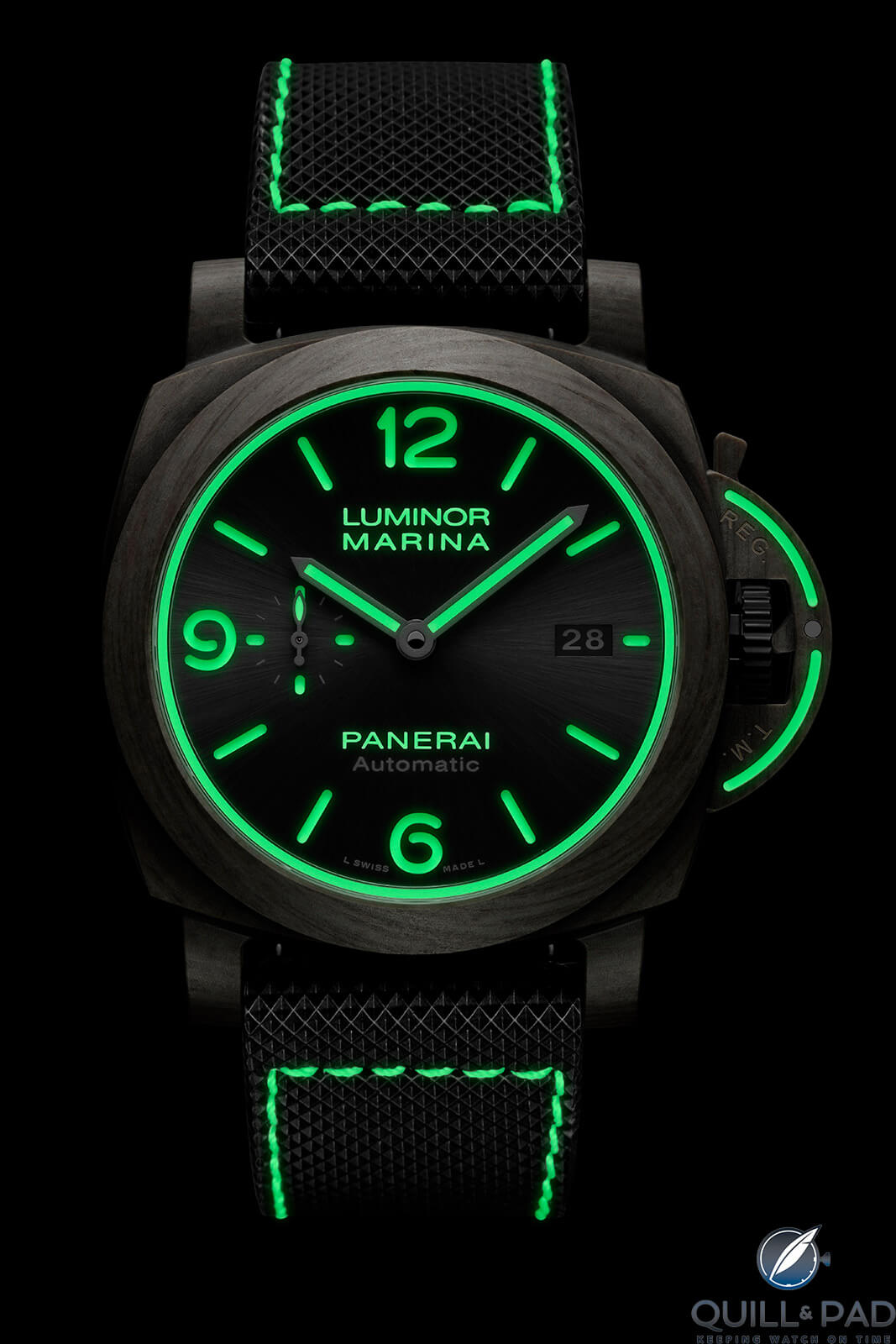
Panerai Luminor Marina Fibratech PAM01119 lume shot
Moreover, the Safety Lock crown protector has a groove following its outside edge filled with lume, adding a wing of light to the case. Finally, the stitching on the strap also glows in the dark, so that the limited edition basically surrounds your entire wrist with glowing light in the dark. That’s great contrast!
Basalt fibers and Fibratech
Even with the changes to the limited-edition version, this model is still about the material innovation of Fibratech, so let’s dig into that. For a bit of background, we should probably look at the history of basalt fibers, which were first developed in – wait for it – 1923. So it’s not exactly brand spanking new.
But in reality that year simply marked the first attempts at utilizing basalt fibers, and for decades the material was relegated largely to experimental military applications as an improvement on glass fibers before carbon fibers became viable.
Basalt fibers are made similarly to glass fibers in that the material is melted and then drawn and stretched through a die to create a long fiber strand, which can then be woven into a thread or different sheet formats or chopped up into long or short strands to be used as filler material in a variety of composites.
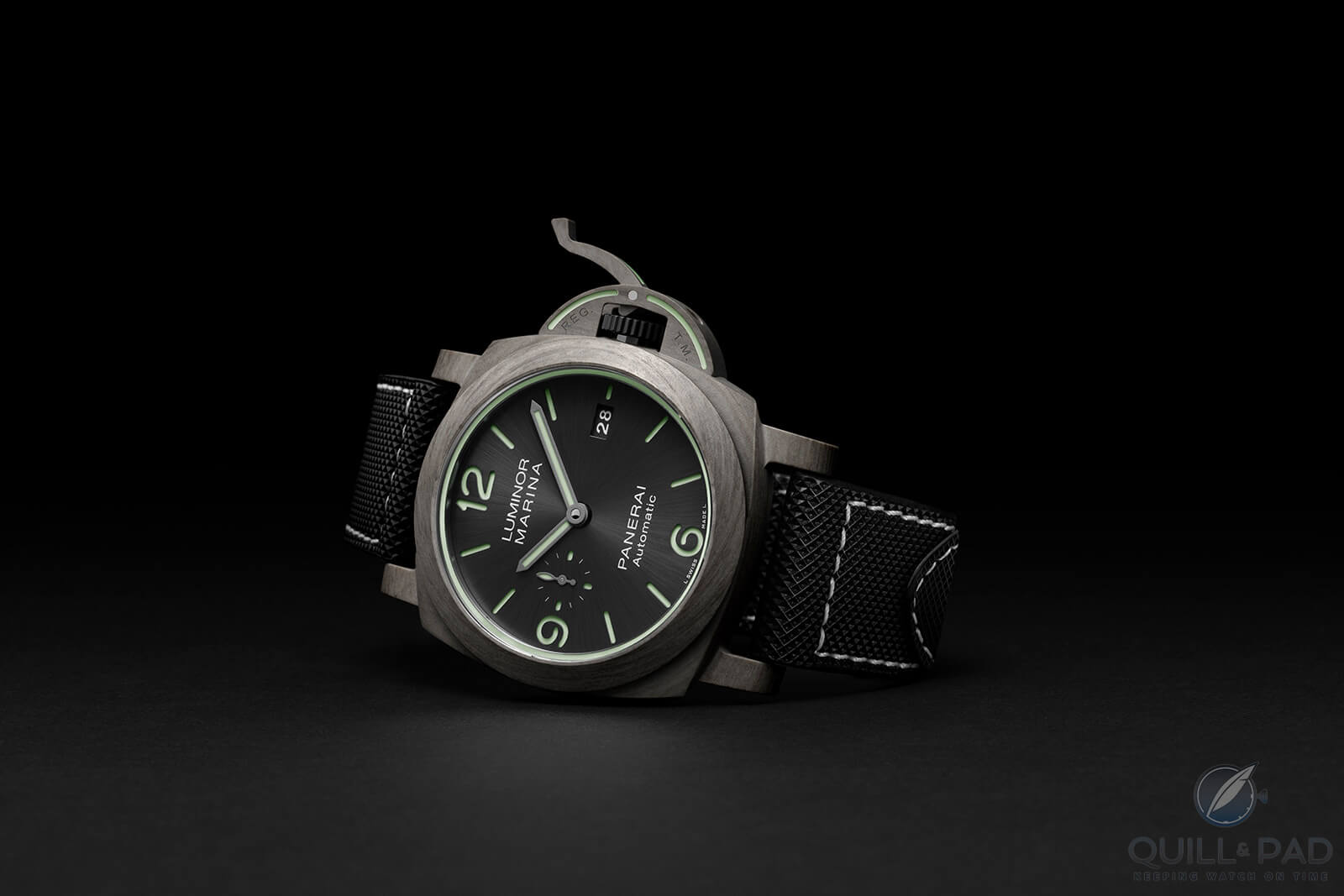
Panerai Luminor Marina Fibratech PAM01119
Basalt fibers are similar in density to glass fibers, meaning they are 35 percent denser than carbon fibers, but 66 percent less dense than steel. When mechanical properties are compared, the basalt fibers improve upon glass fibers by up to 33 percent for tensile strength and can withstand much higher temperatures.
Moreover, basalt fibers have a tensile strength six times that of steel, providing a strong, lightweight replacement for certain applications. This puts basalt fibers comfortably between glass and carbon fibers with a production cost very similar to glass fibers, allowing mechanical improvements and cost savings when carbon fiber is considered “overengineering.”
Over the last few decades, basalt fibers have found their way into a variety of industrial and consumer products. Structural benefits are obvious to certain applications such as wind turbine blade laminates or basalt composite tubes for camera tripods, but it also can have more niche applications like basalt fabric laminates for snowboards and chopped basalt fiber and polymer thermoformed acoustic panels for automotive use.
Most interesting is the replacement of steel rebar for concrete applications. Basalt fiber rods can be used for higher strength and lighter weight reinforcement less prone to chemical degradation and virtually eliminates mechanical separation caused by unequal thermal expansion.
You can even add chopped basalt fibers to the concrete mix itself to improve internal tensile and compression strength, adding possible years to the longevity of the structures built with this material. Clearly basalt fibers have their place.
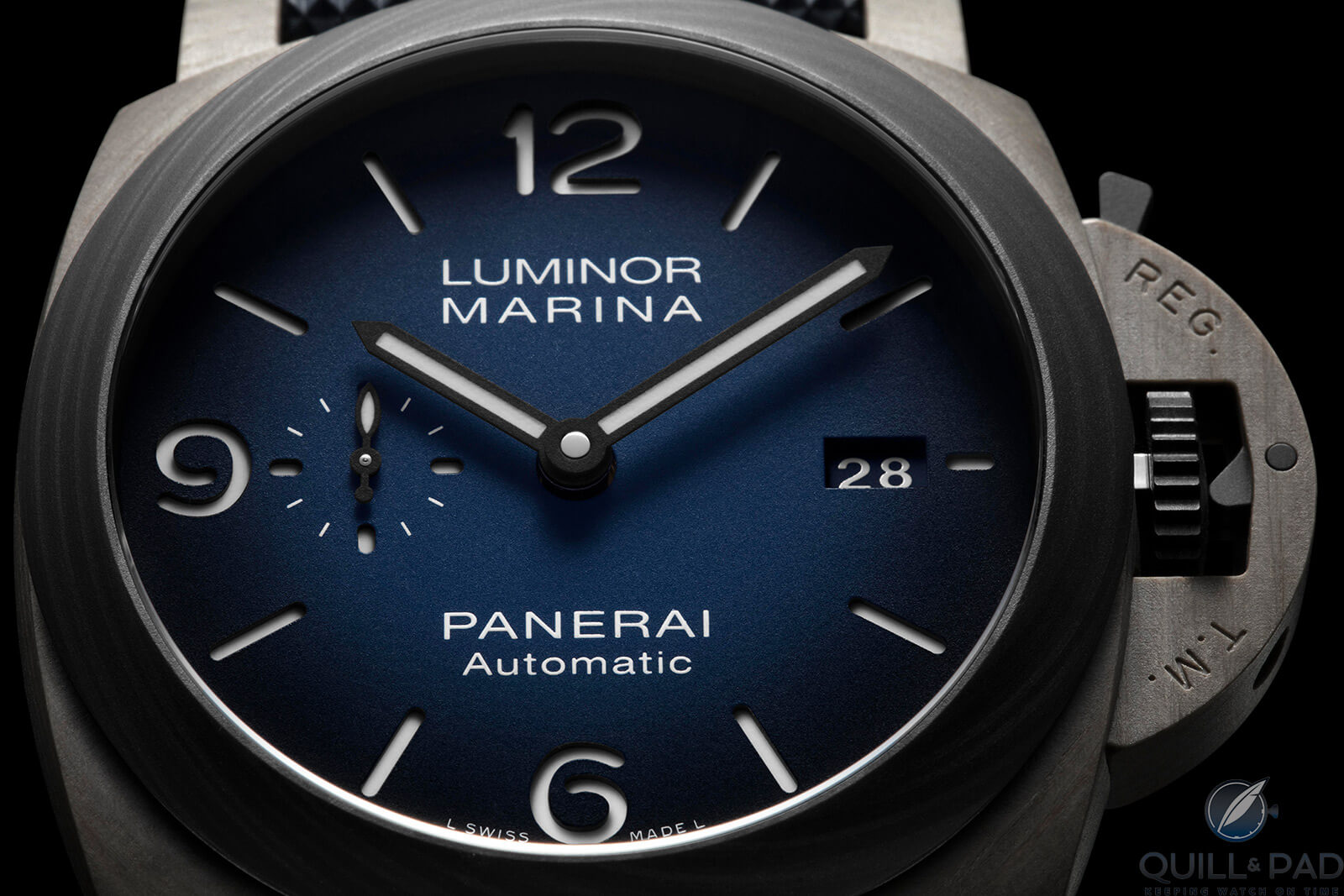
Panerai Luminor Marina Fibratech PAM01663
Fibratech in practice
That’s where we come back to the Luminor Marina Fibratech. The Fibratech material starts with a bundle of unidirectional fibers (meaning they are all aligned in the same direction) that are heated and compressed together with a polymer – a similar beginning as Carbotech. The polymer isn’t specifically named so it may be the PEEK (polyether ether ketone) used in the Carbotech or some other high-temperature chemical resistant polymer.
This creates very thin sheets of basalt fiber polymer composites that are then stacked in specific alternating orientations (a typical layer order for something like this could be 0, 45, 90, -45 degrees) and then compressed again to form a solid block of Fibratech. The resulting solid block can then be machined and finished into the shape of the case, bezel, and Safety Lock crown protector.
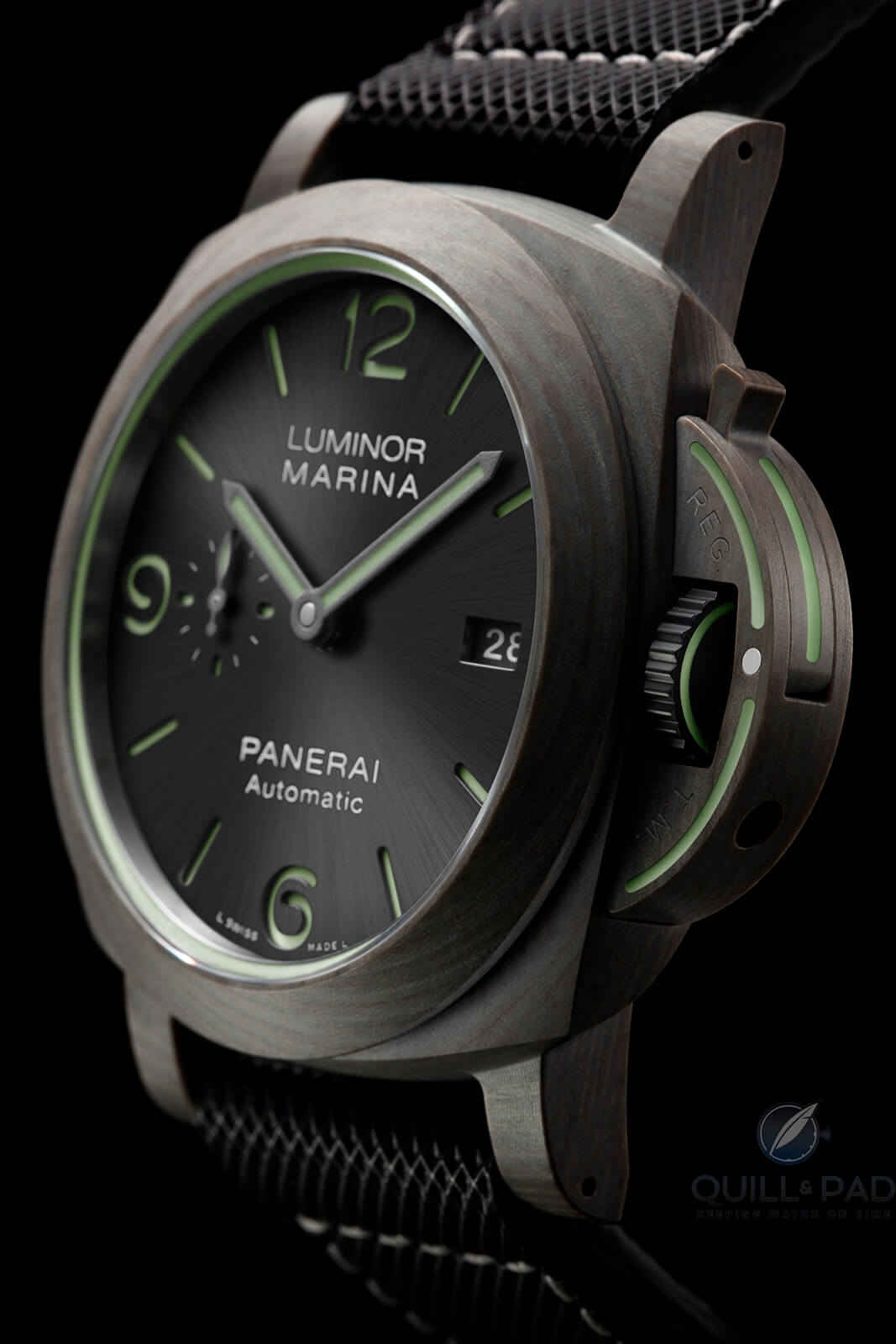
Panerai Luminor Marina Fibratech PAM01119
The Fibratech case is very chemically and thermally stable, fairly light, resistant to cracks and dings, and provides an aesthetic that differs from the much more widely used carbon fiber materials.
To me, this is a great example of understanding what an object needs to do and looking for as many ways to achieve those goals as possible, simply to experiment with materials. Carbotech is undoubtedly lighter and stronger, but for watch cases the cost benefits and the possibility of being less susceptible to cracking (basalt fibers can flex better than carbon fibers) could provide an opening for Fibratech to become a mainstay material in watches.
Richard Mille has also experimented with polymer-based composites, so light and durable composites comprising interesting materials look to have found a niche.
I love that Fibratech uses basalt (because in my mind that just seems so counterintuitive) and builds on material knowledge that Panerai already had with its unique Carbotech – and that the material isn’t the “hardest and lightest and strongest and blah blah blah” material ever made.
Fibratech fits into a niche between two popular composite materials and a traditional material (steel) and provides its own unique benefits in that space. Innovation isn’t always about maxing out every category, otherwise the end goal would probably always be solid diamond, which, unless you are an oil sheikh or Floyd Mayweather, doesn’t sound all that appealing for a watch like this.
The Luminor Marina Fibratech is a cool example of material innovation focusing on the pure act of experimentation. Fibratech is clearly a very cool material, and the aesthetic should attract those on the lookout for something outside the norm.
Carbon fiber is becoming a norm now, and even though it still is an awesomely advanced material, WIS folks like variety – and the Paneristi crave exclusive features that set their watches apart.
When a brand is built solidly around a narrow aesthetic like Panerai, material innovation is one of the best ways to stretch the legs while staying in the same neighborhood. I think this is one of Panerai’s biggest strengths, with each new material innovation adding to its foundation of experimental ideology.
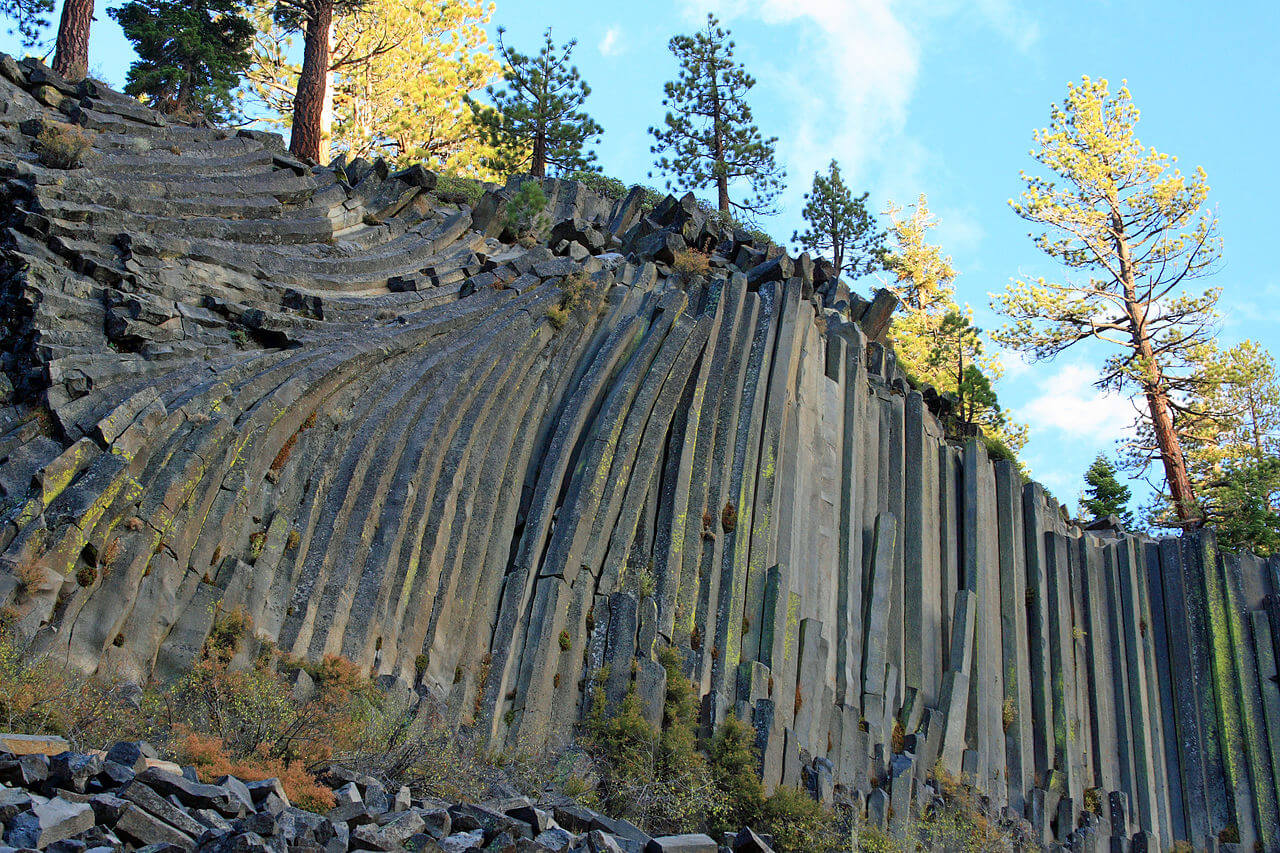
Devil’s Postpile National Monument near Mammoth Lakes, California (photo courtesy Frank Kovalchek/Wikipedia)
And to think this all began with a love for places like the Devil’s Postpile in California is wild!
Even wilder? Trying to break down something designed to be this durable!
- Wowza Factor * 8.4 I am always wowed by continued innovation, and Panerai always steps up with new materials!
- Late Night Lust Appeal * 84» 823.759m/s2 Sometimes the lust comes not from the end result but the technology that goes into it!
- M.G.R. * 51 A nice workhorse movement that will work well and should be protected by the interesting case!
- Added-Functionitis * Minor A date indication, to me, is the most important added function for a watch after a power reserve. It may not be much, but you’ll still need some children’s-strength Gotta-HAVE-That cream for the minor swelling!
- Ouch Outline * 8.444 I shouldn’t have eaten that! Are you allergic to any foods that you absolutely love? Do you still eat those foods even though you know it can (and will) hurt you? Then you know the feeling: satisfaction followed very closely by regret that you never learn from. Still, I’ll take that feeling a hundred times if it meant I got one of these on my wrist!
- Mermaid Moment * Wait, wait, wait, basalt?! I love being utterly surprised by what exactly went into an innovation. When you realize what it is, you know your wedding ideas Pinterest board is about to get ravaged!
- Awesome Total * 770 First add the number of components in the P.9010 movement (200) to the water resistance in meters (300), then for good measure add in the number of pieces in the limited-edition version (270) for a respectably solid awesome total!
For more information, please visit panerai.com/us/en/collections/watch-collection/luminor/pam01119-luminor-marina-fibratech.
Quick Facts Panerai Luminor Marina Fibratech PAM01663 and PAM01119
Case: 44 x 14.5 mm, Fibratech, Carbotech and titanium
Movement: automatic Caliber P.9010 with twin spring barrels, 28,800 vph/4 Hz frequency
Functions: hours, minutes, seconds; date
Limitation: Ref. PAM01119, 270 pieces (boutique only); Ref. PAM01663, non-limited
Remark: limited edition comes with 70-year warranty
Price: $16,000 (non-limited edition), $18,900 (limited edition)
You may also enjoy:
The Panerai Lab-ID Luminor 1950 Carbotech 3 Days With 50-Year Guarantee!
Panerai’s Eco Initiatives: Change Starts From Within (Plus The Submersible Mike Horn Edition 47mm)
Panerai L’Astronomo Luminor 1950 Tourbillon Moon Phases Equation Of Time GMT: Lessons From The Pope
Leave a Reply
Want to join the discussion?Feel free to contribute!





















































THANKS
Quero saber qual é o preço!
Puede enviar valor del modelo y características del reloj en Español